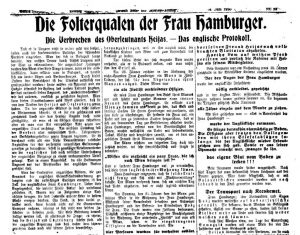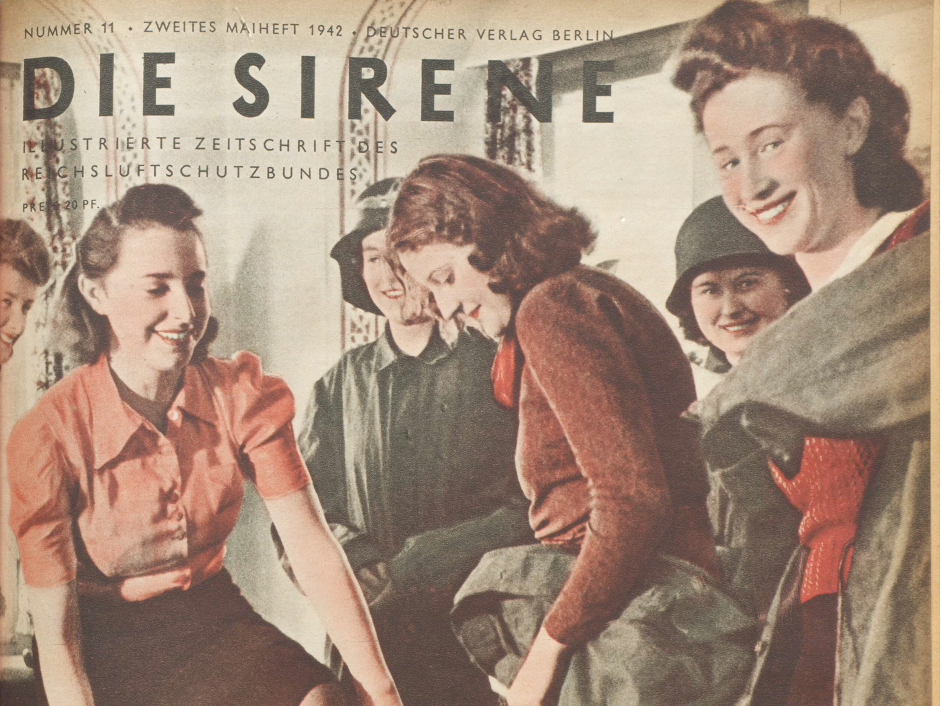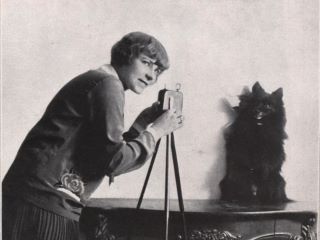Writing about sexualized violence during wartime presents a set of intellectual, ethical, and structural challenges for historians interested in helping women and gender “become visible.”[1]
While researching my dissertation on gender and violence in Hungary’s “long World War I” period, I first encountered what may be the most famous episode of sexualized violence against a woman during the Hungarian White Terror, a period of violence and repression by counterrevolutionary forces against those deemed responsible for the country’s democratic and Soviet revolutions following the 1918 armistice.[2] The story appeared in a 1920 report composed by a delegation of representatives of the British Labour Party and the Trade Unions Congress. The party organized the delegation to investigate conditions in Hungary because of conflicting reports they received from the official British representation in Budapest and Hungarian leftist exiles.[3]
Mrs. Hamburger and the White Terror
The report described the rape and torture of Mrs. Hamburger [in Hungarian, Hamburger Sándorné) and two male acquaintances. In January 1920, thirty-year old Mrs. Hamburger, the sister-in-law of the People’s Commissar of Agriculture, wife of an exiled minor communist official, and mother of three children, was arrested by detectives and taken to an army barracks where members of a White militia detachment were stationed. Over the course of several hours, she was beaten, insulted, forced to sing and dance naked, and penetrated with the handle of a whip. The officers also brought in the male acquaintances, mutilated their genitals, and ordered them to rape Mrs. Hamburger in front of the audience. She was held for nearly four months all together, first in the military barracks and then in two other prisons. One of the men arrested with Mrs. Hamburger, Béla Neumann, died of his injuries, and his body was thrown into the Danube.
Three of the report’s twenty-six pages were devoted to the story and the British Labour delegation’s inquiry into the incident. According to the delegation they received unwritten confirmation of the story from the Hungarian government, which stated that her harsh treatment and injuries were the result of her “misconducting” herself with male cellmates. The delegation doubted this “semi-official” account, as Mrs. Hamburger was deemed a respectable, “well educated” woman of high moral standing.
Subjectivity and Sources
The story of my encounter with Mrs. Hamburger‘ story reflects many of the challenges of being a social historian of women and gender, a feminist historian, and of attempting to do transnational work in contemporary academia. Although it has received attention from other historians working on the period, the British report and its content regarding Mrs. Hamburger is both valuable and limited. It was the first major source I collected for my dissertation, but it was also a source I wanted to shy away from. I feared going where others had tread, and, given the context and the explosion of reports of atrocities during World War I, I wasn’t quite sure it was reliable.
I was also hesitant because Mrs. Hamburger’s voice was absent from the report. I wrote about the story in my dissertation, but I purposefully shied away from presenting on it at conferences or otherwise highlighting it in my narrative, because I did not feel comfortable perpetuating what seemed to be the exploitation of Mrs. Hamburger’s body by the Labour Party and the European left. Moreover, as a social historian, I wanted to learn more about her and place attention on her voice, and get a sense of what she intended when she told her story to the Labour delegation, which had gone to Austria to interview people who escaped to Vienna following the fall of the Hungarian Soviet regime. According to their official itinerary the delegation sought Mrs. Hamburger out and, according to their final report, they interviewed her twice for nearly four hours total.
When I began looking deeper into the story of Mrs. Hamburger, I only had two sources: the delegation’s report and a deposition filed by the brother of one of the other men mentioned in the report. Beyond this, I could find very little about her in other archives in Hungary. Because the Labour report was the source of subsequent references, I visited the Labour Party Archives in Manchester, England, which held the records on the delegation’s visit to Budapest and Vienna. Here I found a deposition she submitted to the delegation.
From an earlier draft of the report, I also learned that a British woman accompanied the delegation and provided invaluable assistance to the official male members of the group by helping them access women who were reticent to speak to men about the abuse they had experienced. This “detail” was absent from the final report, but I was able to verify it through additional work at the New York Public Library. This research has enabled me to tell an increasingly detailed and rich story of Hungary and women during this period of upheaval, and two sources on Mrs. Hamburger have grown to nearly fifty (not including newspapers that reprinted the Labour delegation’s report). Even if I can’t fill in all the gaps, in many ways I feel like I know Mrs. Hamburger very well. But in other ways, I do not. I began my research without her first name. Seven years later, I still don’t know it.
Gender in the Archives
My work on Mrs. Hamburger highlights the difficulties many of us face when we attempt to trace women’s lives in the archives. While there may be some peculiarities with regard to Hungarian naming patterns, when women marry and their legal identities become subsumed under their husbands‘, it makes it more challenging to trace their (legal) lives and movements. More importantly, the filter of marriage, i.e. their relationships with men, shapes—consciously and unconsciously—our assumptions regarding certain dimensions of women’s identity. In the Central and Eastern European context, this includes a host of markers including religion, ethnicity, etc., that challenge our ability to understand and fully grapple with an individual’s historical subjectivity and agency. Furthermore, it reproduces the historical pattern of identifying, categorizing, and, in many cases, punishing a woman solely through her relationships with men.
The case of Mrs. Hamburger also reveals the tensions involved in writing social histories of sexual violence, namely how to take seriously a her testimony while looking for sources to corroborate and contextualize both it and the Labour delegation’s investigation. Threading the needle between trust and scholarly skepticism is challenging in these cases because sexual violence is a crime that has been historically under-reported, and when it is, victims face extensive scrutiny based on various aspects of their identity, occupations, etc. This was certainly the case with Mrs. Hamburger at the time.
The historical context in which she gave her testimony is also challenging because of the ubiquity of sexual violence in reports about the conduct of the “enemy” during World War I and its revolutionary aftermath. Consequently, sexual violence against women could be regarded as an unfortunate, but normal—and possibly justifiable—consequence of conflict, and atrocity stories could be dismissed as sensationalized “propaganda.” In the case of Mrs. Hamburger, the effect of these two dimensions made her simultaneously highly visible to the political left and invisible to the political right. Her story (as narrated and interpreted by the British Labour delegation) was widely disseminated in publications in Europe and around the world affiliated with the labor movement or written and edited by prominent leftists, making her a face of revolutionary virtue and counterrevolutionary debasement in the years after World War One. However, because of its visibility in sources associated with the labor movement, others could ignore her story altogether, or it disregard it as partisan politics.
My goal has been to work through these challenges by exploring the production and goals of the Labour report, which has allowed me to use Mrs. Hamburger’s words to explain the episode of violence and understand the role that she and other women played in producing the report. Through this, I’ve shown that she played a role in publicizing her experience, even though I still don’t know how far she wanted her story to travel. I have also been able to show that sexualized violence against men was treated much differently in narratives of the White Terror, if it was mentioned at all.
The Institutional Limits of Visibility
Mrs. Hamburger’s story, and my attempt to tell it, also reveals the challenges facing historians and archivists in contemporary academic culture. The pressure to broaden the scope of research and to think in transnational and/or international terms has developed at the same time that funding becomes increasingly scarce. Properly contextualizing what happened to Mrs. Hamburger and those who were arrested and tortured with her has required research in more than twelve archives and libraries in five countries, two continents, and five different languages. For many scholars at all stages of their career, undertaking this type of project is daunting, not least from the economic standpoint.
In what seems to be a move to address these financial concerns as well as enhance visibility and utility, many archives have increasingly been putting content online. However, like archival organization itself, digitization involves curatorial decision-making about what is most popular or “useful” to potential researchers, and a researcher is heavily dependent on the depth of knowledge an archivist has of their collection and what they think is important or relevant. Further, the structural challenges that face researchers also affect archives. Digitization is costly, and smaller archives and collections on people, places, and processes regarded as marginal may not be well funded or properly staffed. They may not have the ability to apply for outside funding or undertake digitization projects; it is not uncommon for a single person to staff an entire archive. Moreover, archivist Elizabeth Kata has observed that digitization may actually further decrease the visibility of collections that are not available online, laying bare the limitations facing archives and archivists committed to the idea that their collections can be tools for enhancing social justice.[4]
I am certainly not the first person to note the institutional challenges facing those who work on gendered histories, social history, or transnational and/or global histories, or a combination of the three.[5] Even with the best classroom preparation, there is no singular guide for overcoming them, as each country, each archive, each story is unique. The paucity of evidence often requires bringing together different types of sources that require diverse theoretical and methodological approaches, not to mention the conceptual and ethical issues that arise when you seek to tell someone’s story.
Although it has grown substantially over the past forty years, gender history is still a somewhat niche sub-field, especially in certain regions like East Central Europe. Telling Mrs. Hamburger’s story has, so far, been perhaps the biggest scholarly challenge of my young career logistically, intellectually, but also emotionally. I believe that I am doing her story justice, and that I have properly placed it within both the history of gender and violence and modern European history. Nevertheless, for all these successes, there is still a glaring failure: I still don’t know her first name.
Footnotes
[1] Renate Bridenthal, Becoming Visible: Women in European History, Third Edition (New York: Houghton Mifflin, 1998).
[2] The concept of the “long World War I” refers to a periodization of the First World War that encompasses the on-going military conflict, violence, and political crises that accompanied the collapse of empires and the formation of new or re-formed states, especially but not solely in Central, Eastern, and Southeastern Europe.
[3] The White Terror in Hungary: Report of the British Joint Labour Delegation to Hungary (London: Trade Union Congress and the Labour Party, 1920).
[4] Ricardo L. Punzalan and Michelle Caswell, “Critical Directions for Archival Approaches to Social Justice,” The Library Quarterly 86, no. 1 (2016): 25—42.
[5] See Antoinette Burton, Dwelling in the Archive: Women Writing House, Home and History in Late Colonial India (Oxford: Oxford University Press, 2003) and Antoinette Burton, ed. Archive Stories: Facts, Fictions, and the Writing of History (Durham, NC: Duke University Press, 2006).







[…] The Woman with No First Name; von Emilie Gioielli (Link) […]
[…] The Woman with No First Name; von Emilie Gioielli (Link) […]